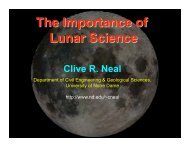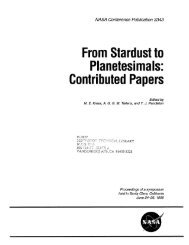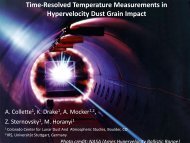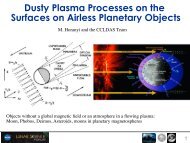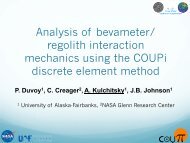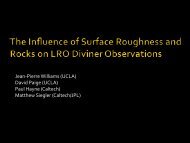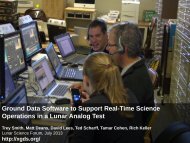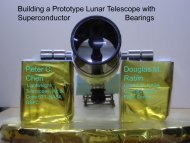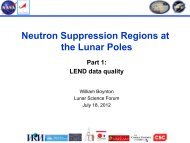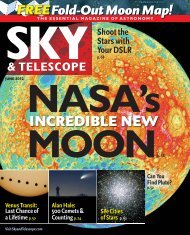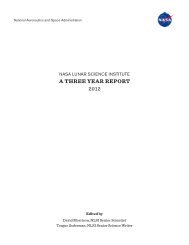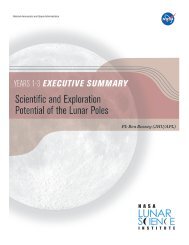LRO Targe!ng of the South Pole - NASA Lunar Science Institute
LRO Targe!ng of the South Pole - NASA Lunar Science Institute
LRO Targe!ng of the South Pole - NASA Lunar Science Institute
You also want an ePaper? Increase the reach of your titles
YUMPU automatically turns print PDFs into web optimized ePapers that Google loves.
<stro<strong>ng</strong>>LRO</stro<strong>ng</strong>> <stro<strong>ng</strong>>Targe</stro<strong>ng</strong>>*<strong>ng</strong> <strong>of</strong> <strong>the</strong> <strong>South</strong> <strong>Pole</strong>-‐Aitken <br />
Basin for <strong>the</strong> Extended <strong>Science</strong> Mission <br />
Brad Jolliff, Washi<strong>ng</strong>ton University, St. Louis, MO <br />
Noah Petro, Goddard Space Flight Center, MD <br />
Sam Lawrence, Julie Stopar, and Mark Robinson, <br />
Arizona State University, Tempe, AZ
• For Explora*on phase <strong>of</strong> <stro<strong>ng</strong>>LRO</stro<strong>ng</strong>>’s mission, <strong>NASA</strong> designated nine <br />
Constella*on sites within and associated with SPA as high-‐priority imagi<strong>ng</strong> <br />
targets. <br />
• These sites have been intensely covered with Narrow A<strong>ng</strong>le Camera (NAC) <br />
imagi<strong>ng</strong>, includi<strong>ng</strong> images suitable for deriva*on <strong>of</strong> geometric stereo. <br />
• Sites include: <br />
SPA Interior SPA Rim (TC) Apollo Basin <br />
Van de Graaff Mare I<strong>ng</strong>enii Schrödi<strong>ng</strong>er Basin <br />
• In addi*on to <strong>the</strong>se, sites on or near <strong>the</strong> rim include: <br />
Aitken Crater <strong>South</strong> <strong>Pole</strong> Malapert Massif <br />
• These sites encompass numerous high-‐priority science objec*ves <br />
ar*culated in <strong>the</strong> NRC SCEM Report and <strong>the</strong> Decadal Survey. <br />
• Extended <strong>Science</strong> Mission orbit is ideal for sou<strong>the</strong>rn hemisphere imagi<strong>ng</strong>, <br />
includi<strong>ng</strong> images for high-‐resolu:on geometric stereo analysis.
Ø One <strong>of</strong> <strong>the</strong> richest scien*fic <br />
targets on <strong>the</strong> Moon <br />
– Major unsampled “terrane” <br />
– What are <strong>the</strong> materials <strong>of</strong> <strong>the</strong> <br />
lower crust and upper mantle <br />
<strong>of</strong> <strong>the</strong> Moon <br />
– How did <strong>the</strong> Moon <br />
differen*ate <br />
– Does Moon record an early <br />
“cataclysmic” bombardment <br />
within <strong>the</strong> Solar System <br />
Iden*fied as a high priority for Solar System Explora*on <br />
by <strong>the</strong> 2003 & 2012 NRC Decadal Surveys
Ø SPA Giant Impact <br />
– How deep did <strong>the</strong> SPA impact <br />
excavate Hundreds <strong>of</strong> km <br />
– What were <strong>the</strong> impact <br />
parameters (size, velocity, <br />
a<strong>ng</strong>le) <br />
– What is <strong>the</strong> composi*on <strong>of</strong> <br />
SPA impact melt <br />
– What are <strong>the</strong> clast contents <br />
– Did <strong>the</strong> impact-‐melt complex <br />
differen*ate <br />
What was <strong>the</strong> role <strong>of</strong> SPA in <strong>the</strong> early establishment <br />
<strong>of</strong> <strong>the</strong> Moon’s megaregolith and its composi*on
What was <strong>the</strong> role <strong>of</strong> SPA in establishi<strong>ng</strong> early <br />
lunar upper-‐crustal deposits <br />
Remote sensi<strong>ng</strong> data imply anorthosite <br />
buried beneath a more mafic surface <br />
layer, sugges*<strong>ng</strong> gross layeri<strong>ng</strong> as <br />
shown in <strong>the</strong> figure. <br />
Why is anorthosite in <strong>the</strong> middle and <br />
not on top <br />
A deep mega-‐regolith developed <br />
from early era <strong>of</strong> basin impact ejecta <br />
accumula*on – perhaps dominated <br />
by SPA ejecta. <br />
Gabbroic anorthosite, <br />
nori*c anorthosite <br />
Anorthosite <br />
More mafic material <br />
(anorthosi*c norite, <br />
gabbro, troctolite)
– How do far-‐side basalts differ from <br />
those sampled on <strong>the</strong> near side <br />
– How do far-‐side <br />
mantle sources <br />
differ from near <br />
side <br />
Basalt"<br />
Cryptomare"<br />
Pyroclastics"<br />
– What are <strong>the</strong> implica*ons for global asymmetry <br />
– Direct informa*on on far-‐side mantle beneath <br />
SPA Basin.
What is <strong>the</strong> cause <strong>of</strong> <strong>the</strong> <br />
“background” thorium <br />
content <br />
-‐ Does it represent <strong>the</strong> <br />
Moon’s lower crust <br />
-‐ Does it represent an <br />
integra*on <strong>of</strong> lower crust <br />
and upper mantle <br />
What is <strong>the</strong> cause <strong>of</strong> <strong>the</strong> two <br />
anomalies <br />
-‐ Oresme V Crater <br />
-‐ Birkeland Crater <br />
What are <strong>the</strong> implica*ons for <br />
<strong>the</strong>rmal evolu*on <strong>of</strong> <strong>the</strong> <br />
Moon
What is <strong>the</strong> source <strong>of</strong> <br />
<strong>the</strong> mafic signature <br />
-‐ Lower crust <br />
-‐ Upper mantle <br />
-‐ Mare/cryptomare <br />
What lithologic <br />
components contribute <br />
to <strong>the</strong> composi*onal <br />
signature
• Basin Chronology, Bombardment History <br />
• Composi*on, Mineralogy <strong>of</strong> <strong>Lunar</strong> Interior <br />
– Lower Crust, Upper Mantle; Crustal Dichotomy <br />
• Farside Basalts, includi<strong>ng</strong> Cryptomare <br />
• Intra Basin Plains Deposits <br />
• Thorium/KREEP Distribu*on <br />
• Magne*c Anomalies
Many individual images <br />
Coverage as <strong>of</strong> June 2012 PDS release
Not many geometric stereo images <br />
As <strong>of</strong> June 2012
I<strong>ng</strong>enii <br />
Aitken <br />
Van de Graaff <br />
Apollo <br />
Das <br />
Rim <br />
Interior <br />
Antoniadi <br />
Schrödi<strong>ng</strong>er <br />
Malapert, S. <strong>Pole</strong>
• <stro<strong>ng</strong>>LRO</stro<strong>ng</strong>>C NAC DTMs are made from <br />
geometric stereo pairs (two images <strong>of</strong> <br />
<strong>the</strong> same area on <strong>the</strong> ground, taken <br />
from different view a<strong>ng</strong>les under <br />
nearly <strong>the</strong> same illumina*on). <br />
• <stro<strong>ng</strong>>LRO</stro<strong>ng</strong>>C not designed as a stereo system, <br />
but can obtain stereo pairs through <br />
images acquired from two orbits -‐ <br />
with at least one <strong>of</strong>f-‐nadir slew. <br />
• Off-‐nadir slews interfere with <strong>the</strong> data <br />
collec*on <strong>of</strong> o<strong>the</strong>r instruments, so <br />
<stro<strong>ng</strong>>LRO</stro<strong>ng</strong>>C slew opportuni*es are limited.
• In <strong>the</strong> ESM, per year: <br />
– Four months with illumina*on suitable for geometric stereo <br />
– Two stereo pairs per day <br />
– Max ~ 48 total pairs in SPA <br />
• For la*tudes south <strong>of</strong> 60 degrees <br />
– One month duri<strong>ng</strong> each beta cycle available for geometric <br />
stereo <br />
• 40-‐60 degrees incidence is best for good geometric <br />
stereo solu*on <br />
• A geometric stereo NAC pair covers only an area <strong>of</strong> <br />
about 5 x 25 km; for large areas use WAC GLD100 <br />
DEM <br />
• NAC stereo images require a lot <strong>of</strong> resources.
• <stro<strong>ng</strong>>LRO</stro<strong>ng</strong>>C Web: <br />
hjp://wms.lroc.asu.edu/lroc/dtm_select <br />
• LMMP <br />
hjp://pub.lmmp.nasa.gov/LMMPUI/LMMP_CLIENT/<br />
LMMP.html <br />
• See also: <br />
hjp://wms.lroc.asu.edu/lroc/dtm_about <br />
hjp://www.asprs.org/a/publica*ons/proceedi<strong>ng</strong>s/orlando2010/files/Tran.pdf <br />
Rosiek et al. (2012) USGS digital terrain models and mosaics for LMMP. 43 rd <strong>Lunar</strong> <br />
Planet. Sci. Conf., #2343. <br />
Majson et al. (2012) Regional digital terrain model produc*on with <stro<strong>ng</strong>>LRO</stro<strong>ng</strong>>C-‐NAC. <br />
43 rd <strong>Lunar</strong> Planet. Sci. Conf., #2630.
160W <br />
Bose <br />
Bhabha <br />
Bhabha <br />
<strong>South</strong> <br />
Bhabha <br />
East <br />
Plains <br />
Mafic <br />
Mound <br />
SPA-‐I <br />
(Cx) <br />
60S
Constella*on ROIs <br />
NAC Stereo Coverage <br />
160W <br />
60S
Topography <br />
Slopes <br />
Archinal et al., <br />
LPSC 42 (2011) <br />
From LMMP Portal
SPA Rim <br />
Constella*on site <br />
Center Lat: 51°S <br />
Center Lon: 171°E <br />
Topography <br />
Slopes <br />
Elevation, m<br />
Hess Z <br />
Crater <br />
17.0 km <br />
LMMP Portal, DTM by ASU
Bhabha East Plains <br />
Center Lat: 55°S <br />
Center Lon: 198°E <br />
Color Shaded <br />
Relief Map <br />
Slope <br />
Map <br />
Eleva*on, m <br />
Bhabha <br />
Crater <br />
ASU
Slope and Roughness <br />
Analysis (NAC DEM) <br />
DEM Posts: 1.5 m <br />
Finest scale slope: 3 m <br />
Can stretch to bri<strong>ng</strong> out <br />
detail ( see area in <br />
yellow box) <br />
0-‐max slope (degrees)
Van de Graaff <br />
O’Day <br />
Mare I<strong>ng</strong>enii
Mare I<strong>ng</strong>enii <br />
Center Lat: 35°S <br />
Center Lon: 164°E <br />
Topography <br />
Slopes <br />
Elevation, m<br />
-‐2350 <br />
-‐2480 <br />
-‐2740 <br />
-‐2870 <br />
-‐3130 <br />
-‐3390 <br />
-‐3650
Oppenheimer <br />
U <br />
Dark <br />
halo <br />
Apollo <br />
Basin <br />
WAC GLD100
70S <br />
75S <br />
Peak Ri<strong>ng</strong> <br />
& Graben <br />
Pyroclas*c <br />
Deposit & <br />
Vent <br />
Ri<strong>ng</strong> <br />
120E <br />
140E <br />
WAC Global <br />
WAC GLD100
170W <br />
70S <br />
Deepest point on Moon <br />
Deep crater <br />
WAC Global <br />
WAC GLD100
Ø Fill NAC gaps <br />
Ø Geometric stereo for key targets <br />
Ø <strong>Science</strong> Community Input <br />
• For geometric stereo image requests, <br />
contact Noah Petro (GSFC) (or Brad Jolliff) <br />
noah.e.petro@nasa.gov <br />
blj@wustl.edu <br />
-‐ Include site coordinates; WAC base image to show extents; <br />
<strong>Science</strong> & explora*on ra*onale. 1-‐2 page write-‐up <br />
As soon as possible – <stro<strong>ng</strong>>LRO</stro<strong>ng</strong>> is currently in good illumina*on for SPA <br />
geometric stereo; no later than LEAG mee*<strong>ng</strong>, Oct. 22-‐24, 2012.



